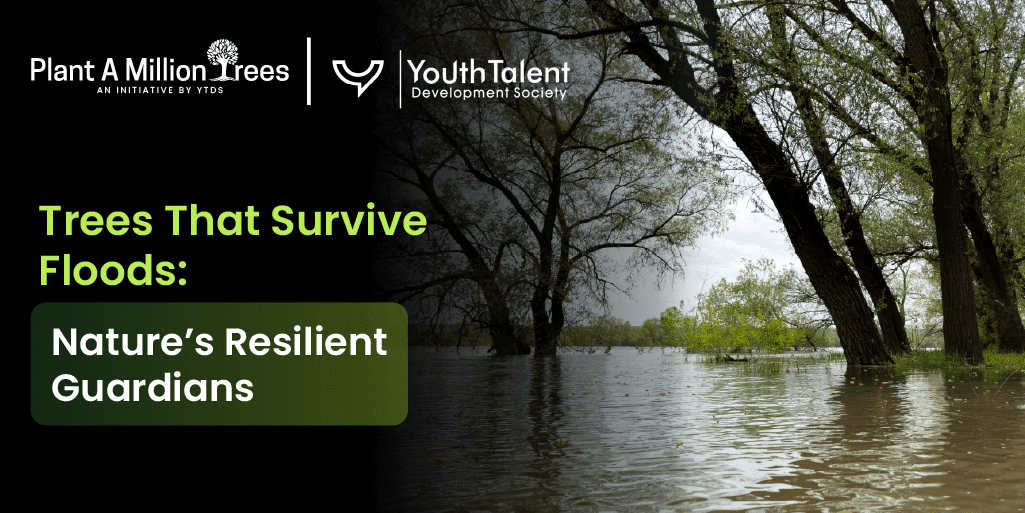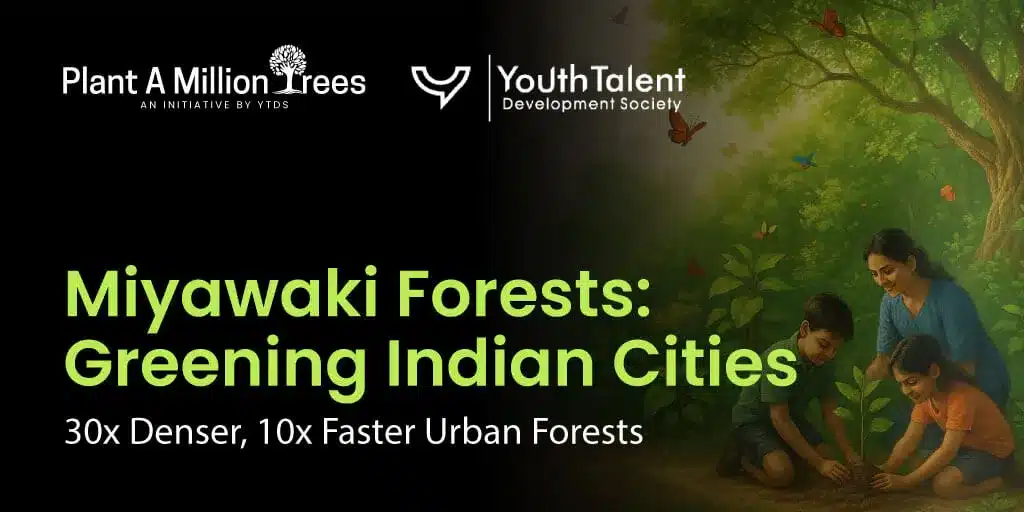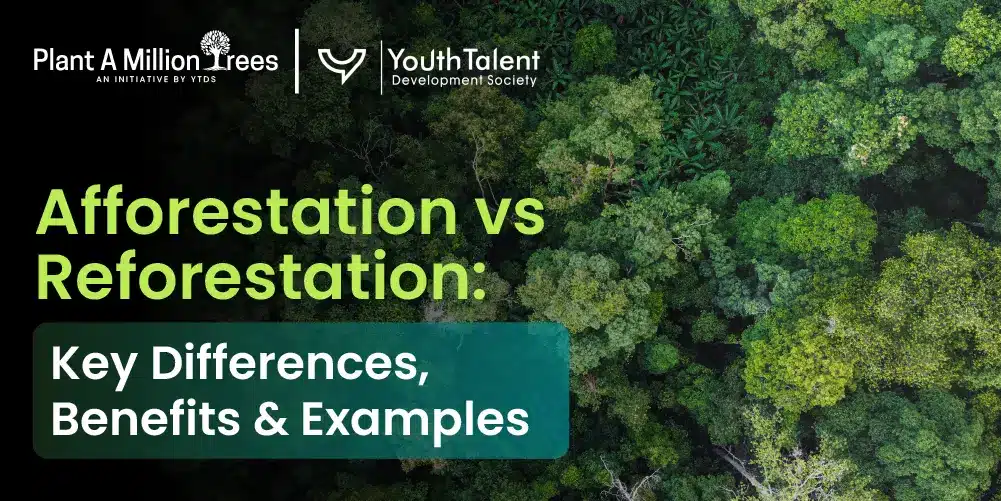India is at a crossroad of corporations. The Corporate Social Responsibility (CSR) is no longer a goodwill thing that...
Urban and rural flooding is a major issue in India according to the rising number of such incidences like overflowing Brahmaputra in Assam, flash floods in Uttarakhand and underwater streets in Chennai and Mumbai.
Floods have become an annual menace due to climate change, urban sprawling and ineffective drainage mechanisms. Through this mess, probably one of the strongest forces of nature is usually overlooked, and that is the trees that survived the flooding. These tidy types don not only survive the attack of waters but they assist in preventing them.
The blog examines the flood-tolerant trees of India and their advantages, their cultivation, and how important they are as climate buffers.
How Trees Help Manage Floods
Floods are disastrous as they cause soil to be washed away, floods flood and fast runoff. But, survivor trees would serve as natural barriers to floods. Their roots hold the soil and keep it away from erosion, and canopies lower the velocity of rain as it falls.
The roots of trees take in and store water, making soil permeable and reducing the speed of carrying floodwater. This minimizes the surface runs which can somehow recharge ground water and eventually avert immediate stagnation of water.
These species that have deep rooted (Terminalia arjuna and Barringtonia acutangula) are especially useful in flood moderation since they can survive flooded status of prolonged duration and would still manage the banks even when there is long-term water logging. The result?
Clearer water supply, better soil material, less radical floods.
Top 10 Trees That Can Survive Floods

Diversity in climate in India gives an opportunity to cultivate a great number of flood resistant trees that are also native to the subcontinent or well-adjusted to ecological zones of its regions.
1. Terminalia arjuna (Arjuna Tree):
The Arjuna is the common tree that is seen along the banks of the river and is very flood tolerant. It has deep roots that hold soils and reduce soil erosion and high canopy that slows down rainfalls.
2. Barringtonia acutangula (Indian Oak):
This tree is commonly referred to as a swamp tree and it fits in wet areas and low lying flooding grounds. It grows even when submerged in water over long period of time.
3. Salix tetrasperma (Indian Willow):
It grows close to streams and lakes and this tree has a high water absorption rate hence, making it one of the best trees which survive in the northeast area of India during floods.
4. Syzygium cumini (Jamun):
Native in India and very enhance in flood tolerance, the root system of the Jamun tree can absorb the standing water and it plants riverbank plantations.
5. Melaleuca leucadendra (Cajeput Tree):
The tree is a swamp tolerant tree of the Myrtaceae family which is currently cultivated in flood mitigation areas of Kerala and Eastern Ghats.
6. Ficus religiosa (Peepal Tree):
In addition to religious significance, the Peepal trees are characterized with strong roots and tolerance to floods especially those planted in semi urban catchments.
7. Tamarix dioica (Tamarisk):
Can be found planted on wetlands, it is a hardy species and it flourishes in salty and wet areas hence suitable in flood-prone coastal regions.
8. Mangroves (Rhizophora and Avicennia):
These are trees are called mangroves which grow in Sundarbans and act as natural barriers to floods. Their stilt roots decelerate tidal surges and shelters the coastal life.
9. Acacia nilotica (Babool):
Babool is tolerant to fluctuations in water level and can be used in semi-arid as well as in the restoration of riverbanks.
10. Pongamia pinnata (Karanj Tree):
This tree is resistant to drought and flooding making which would suit the regions that experience water extremities periodically.
These trees do not merely batten down the hatches in terms of disasters, they are also ecosystem developers, providing food, cover and habitat to wildlife and, incidentally, punching floods.
Where and When to Plant These Trees
The location of the plant is as important as the plant. Trees that have resistance to floods are most appropriate in India:
- 1. Riparian areas (Riverbanks, streams, Lakes)
- 2. Swamps and marshes
- 3. Stormwater drainage systems and water detention tanks in cities
- 4. The seasonal flooding of farmland that is low-lying
- 5. Recharge trenches at sides of the roadways
Tree plantation in floodplain in states such as Assam, Bihar, Kerala and Odisha is ideally done at pre-monsoon months (April to June). This will guarantee that saplings have had a chance to root before accumulation of water.
Plant native or regionally-adaptive species, and in-site plant together so that the ecological buffering is stronger when in a cluster of trees rather than an isolated tree.
Case Studies From India
1. Kaziranga National Park Buffer Zone Reforestation (Assam)
Kaziranga is an annual flooding area as Brahmaputra River swells and moves the creatures such as rhinos and elephants along the roads, which contribute to wildlife deaths and road disruption.
More recently, the Assam Forest Department and conservation NGOs began possible solutions to the buffer zone by re-establishing a native species, smaller flood tolerant species, such as Jamun and Arjuna.
These are green belts that minimize the speed of floods, minimize land erosion and form high grounds, which are taken as shelter during monsoons by the wild life. This strategy has favored eco-tourism sustainability and biodiversity.
2. Miyawaki Forests in Mumbai’s Flood Zones (Maharashtra)
The eastern suburbs of Mumbai such as Mulund and Chembur have been bound to regular flash flooding. In 202122, Brihanmumbai Municipal Corporation (BMC) joined with local ecology groups to establish thick Miyawaki forests in low-lying parks and other public lands.
Those species were Peepal, Pongamia, Neem and Barringtonia selected due to their deep roots and their tolerance to water. These mini forests do not only help decrease the heat islands but also become natural flood sponges that absorb the excess rain during heavy rainfalls.
3. Ramnagar Urban Forest Development (Uttarakhand)
Ramnagar located in the outskirts of Corbett National Park near foothills towns is subjected to flash floods due to the monsoon frequently.
With community activity Nainital district administration has initiated a reforestation program on the degraded slopes of Indian Oak, Sal and Rhododendron.
The trees were chosen based on their skills on surviving during the floods and their role in slope stabilization. Landslides were checked, ground water filtration increased, and even employed tribal youth in maintaining forests that made it green employment.
4. Periyar Riverbank Green Belt Project (Kerala)
The state government considered weak riverbanks as the main vulnerability following the 2018 Kerala floods. With the help of the CSR of private companies, the Periyar Riverbank Green Belt Initiative was established, in which Syzygium cumini, Terminalia arjuna and Vetiver grass have been planted in sensitive areas.
The trees served to stabilise soil and mitigate against spillage of water in the neighbouring paddy fields. These plantations also survived the 2021 monsoon floods and this shows the extent to which vegetative buffers can have long lasting potential in flood management along rivers.
5. Majuli Island Ecosystem Restoration (Assam)
The largest river island in the world, Majuli has lost a considerable area due to the flood and erosion. The Forest Department and other Non Governmental organizations have introduced afforestation campaigns through the planting of indigenous swamp trees such as Barringtonia and Babool.
To create plantations locally, there was the development of community nursery, to ensure the adaptation to local soils and flood periods. The project is also an element of a climate resilience plan, which ensures preservation of the cultural heritage of the island, preventing further reduction.
All of these case studies underline the importance of providing strategic planning of tree planting and ecological plans to turn the space of flood-prone areas into sustainable ecosystems protecting both human properties and biodiversity.
They illustrate the essence of flooding-tolerant trees as natural, scalable and sustainable solutions to India increasing flood problems.
Tips for Maintaining Trees in Flood Zones
The flood prone areas are special areas. The following are some of the care tips that help to survive:
- Prevention of root rots: By use of raised mounds or trenches to prevent waterlogging of the sapling bases, root rots are prevented.
- Improvement of drainage: To achieve lateral drainage of water by perforated ring trench or using judgments on slope designs.
- Mulching: Cover the seedbed with a coarse organic mulch to protect the bed against evaporation and moderate temperature of the soil.
- Fungal disease: Provide protection against rot and blight of young trees by using bio-fungicides made of neem after monsoon.
- Adjustable stakes: Adjustable stakes can be used to hold saplings in high flow areas.
Select saplings that have a good taproot and where possible plant in masses to support each other with canopy and roots.
Why Trees Matter for Long-Term Flood Resilience
The extent of India water problems is so huge that it cannot be solved by flood control infrastructure alone such as storm drains and embankments.
The thing about trees that makes them indispensable is that they silently work all-year-round. Their roots serve as natural sponges, their trunks retard the flow of waters and their existence stabilizes microclimates.
Additionally, trees also enhance the quality of air, increase biodiversity and better the state of soil, which are critical elements in the development of cities that are ready to face the climate.
Since most Indian cities start being listed as prone to impacts of extreme climatic events, tree-based interventions create a combination of resiliency and regeneration.
Conclusion
It is no longer beautification to grow flood resistant trees since the climate threats are increasing. These species provide flood alleviation, ecosystem restoration and climate resilience, all in one.
Regardless of whether you are a policymaker, school principal, urban planner or concerned citizen there is a job to be done.
Begin with the vicinity of where you are: plant a Peepal near a drain, a Jamun near your school or a Barringtonia at a wayside. Each tree matters. What counts was every drop saved.
We were saying, shall we take our ecosystems back tree by tree, because the time to plant a flood guardian is now. The next best time is this instant.




